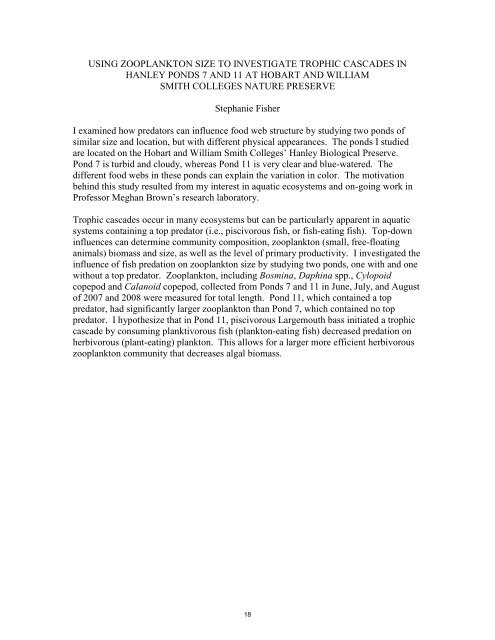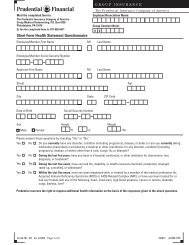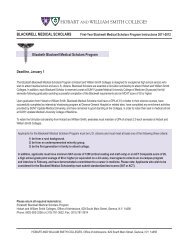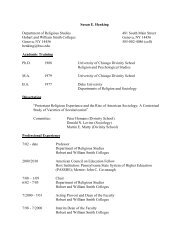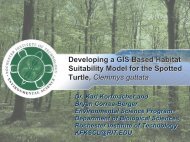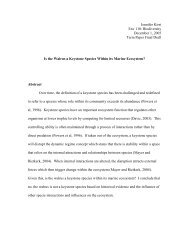share your intellectual passions - Hobart and William Smith Colleges
share your intellectual passions - Hobart and William Smith Colleges
share your intellectual passions - Hobart and William Smith Colleges
You also want an ePaper? Increase the reach of your titles
YUMPU automatically turns print PDFs into web optimized ePapers that Google loves.
USING ZOOPLANKTON SIZE TO INVESTIGATE TROPHIC CASCADES INHANLEY PONDS 7 AND 11 AT HOBART AND WILLIAMSMITH COLLEGES NATURE PRESERVEStephanie FisherI examined how predators can influence food web structure by studying two ponds ofsimilar size <strong>and</strong> location, but with different physical appearances. The ponds I studiedare located on the <strong>Hobart</strong> <strong>and</strong> <strong>William</strong> <strong>Smith</strong> <strong>Colleges</strong>’ Hanley Biological Preserve.Pond 7 is turbid <strong>and</strong> cloudy, whereas Pond 11 is very clear <strong>and</strong> blue-watered. Thedifferent food webs in these ponds can explain the variation in color. The motivationbehind this study resulted from my interest in aquatic ecosystems <strong>and</strong> on-going work inProfessor Meghan Brown’s research laboratory.Trophic cascades occur in many ecosystems but can be particularly apparent in aquaticsystems containing a top predator (i.e., piscivorous fish, or fish-eating fish). Top-downinfluences can determine community composition, zooplankton (small, free-floatinganimals) biomass <strong>and</strong> size, as well as the level of primary productivity. I investigated theinfluence of fish predation on zooplankton size by studying two ponds, one with <strong>and</strong> onewithout a top predator. Zooplankton, including Bosmina, Daphina spp., Cylopoidcopepod <strong>and</strong> Calanoid copepod, collected from Ponds 7 <strong>and</strong> 11 in June, July, <strong>and</strong> Augustof 2007 <strong>and</strong> 2008 were measured for total length. Pond 11, which contained a toppredator, had significantly larger zooplankton than Pond 7, which contained no toppredator. I hypothesize that in Pond 11, piscivorous Largemouth bass initiated a trophiccascade by consuming planktivorous fish (plankton-eating fish) decreased predation onherbivorous (plant-eating) plankton. This allows for a larger more efficient herbivorouszooplankton community that decreases algal biomass.18


